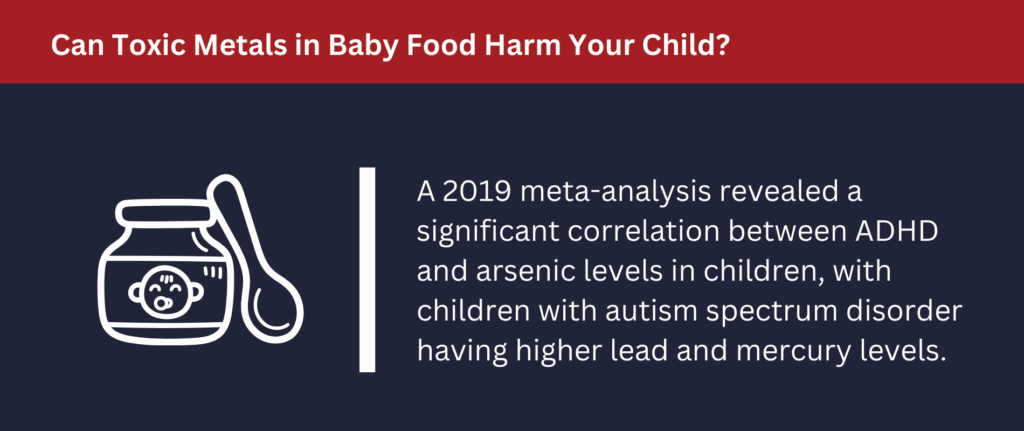
You may have heard that some baby foods contain toxic heavy metals. That’s because a U.S. House of Representatives report from February 2021 stated that many baby foods that were tested contained high levels of heavy metals, such as lead, arsenic, cadmium, and mercury.
According to the report, some of the baby foods tested had as much as:
- 177 times the FDA’s allowable level of lead
- 91 times the allowable level of arsenic
- 69 times the allowable level of cadmium
- 5 times the allowable level of mercury
These are alarming numbers, and you may be wondering if toxic heavy metals in baby food can harm your child.

This article will go into detail about how your child may be harmed by toxic heavy metals in baby food.
The heavy metals named in the report (lead, arsenic, cadmium, and mercury) have been linked to ADHD and autism spectrum disorder (ASD) by numerous scientific sources:
• A 2019 meta-analysis discovered a statistically significant correlation between ASD and elevated arsenic levels in hair and blood. The meta-analysis found that “consistent evidence” exists associating exposure to arsenic in early life and ASD diagnosis.
• A 2018 study found that children diagnosed with ASD possessed significantly higher blood levels of arsenic, noting that the study’s results were consistent with multiple previous studies.
• A 2016 study found that census tracts with lead air concentrations in the highest quartile saw significantly more ASD diagnoses than census tracts with lead air concentrations in the lowest quartile.
• A 2015 study found that autistic children had higher levels of lead in their hair compared to children without ASD.
• A 2017 study found that autistic behavior in 5-year-old children was associated with mercury blood levels during early childhood and late pregnancy.
• A 2003 study discovered “greatly increased” urinary mercury concentrations in children with ASD compared to the concentrations in children without ASD.
• A 2021 study found that autistic children had higher levels of cadmium in their hair than children without ASD.
• A 2020 study found that exposure to inorganic arsenic was associated with ADHD in children, noting that the study “provides additional evidence to existing literature” about the role of toxic metals in the behavior of children.
• A 2019 review found an association between ADHD and lead, stating that “even low levels of lead” raise a child’s risk of being diagnosed with ADHD.
• A 2013 meta-analysis found an association between lead exposure and inattention symptoms and found an association between lead exposure and impulsivity/hyperactivity symptoms.
• A 2018 study found that cadmium was associated with ADHD diagnosis and ADHD symptom severity.
Arsenic has also been linked with cognitive deficits, neurological issues, nervous system damage, brain damage, reduction in IQ, skin cancer, lung cancer, and bladder cancer.
Cadmium has also been linked with cancer, learning disabilities, neurotoxicity, kidney damage, bone damage, and heart damage.
Lead has also been linked with brain damage, reduction in IQ, attention deficits, and behavioral problems.
Mercury has also been linked with a reduction in IQ, impaired memory, cardiovascular disease, and vision impairment.
Heavy metal exposure, in general, has been linked with permanent deficits in the IQ of children, as well as a higher risk of future criminal and antisocial behavior.
Baby foods made by the following companies have been found to have toxic heavy metals in them:
• Gerber
• Beech-Nut
• Parent’s Choice (Walmart brand)
• Sprout Organic Food
• Earth’s Best Organic
• Happy Family Organics
• HappyBABY
• Plum Organics
Healthcare providers consider assessing children for ASD when children display:
• Regular issues with communication or social interaction
• Repetitive or restricted behaviors, which are often referred to as “stimming”
• Restricted interests or resistance to changes
Common ADHD symptoms include impulsivity, disruptive behavior, hyperactivity, and inattention.
For an ADHD diagnosis, the symptoms need to be present for six months or longer and must be present to a much higher degree than in other people of the same age. The symptoms need to be present in two or more settings, such as school and home, and must directly reduce the quality of or interfere with functioning.
ADHD must be diagnosed by a qualified mental healthcare professional or physician.
Nadrich Accident Injury Lawyers Can Help You Secure Compensation in a Baby Food Lawsuit
Call us or contact us online today for a free consultation if your child has developed ASD after eating baby food. You may be entitled to financial compensation in a toxic baby food lawsuit if your child was diagnosed with ASD after eating any of the baby foods listed above.
We don’t charge a fee unless and until we obtain a recovery, so it will never cost you a penny out of your own pocket for us to represent you.

